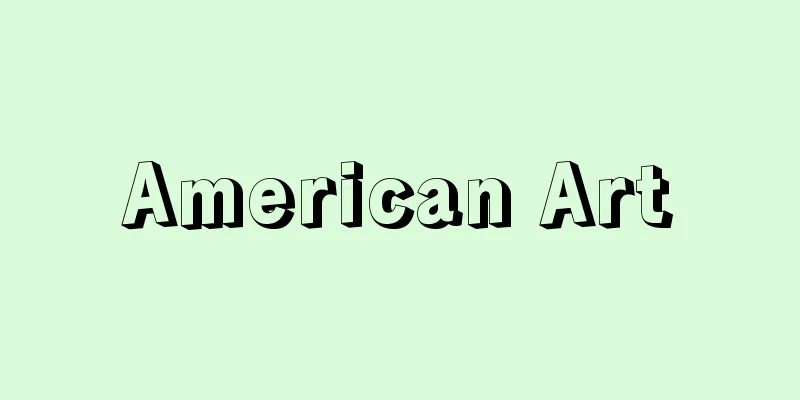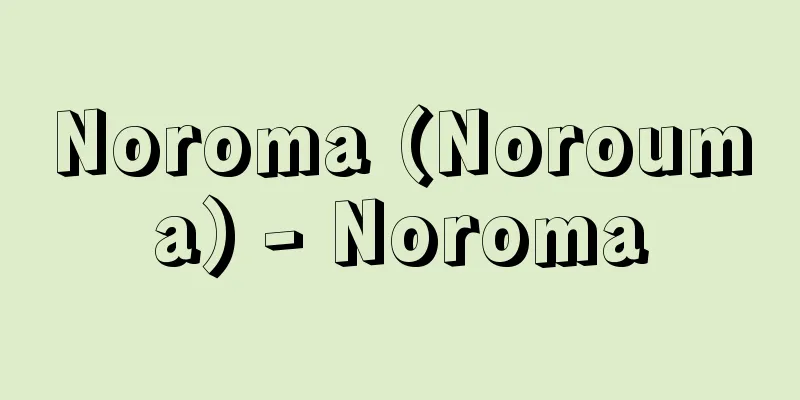American Art

|
American art is an art form formed by the combination of two conditions: a multi-racial democratic society and vast natural landscapes. Less than two and a half centuries have passed since the beginning of American art history, but the path that American art has taken, which has never had traditions to inherit or destroy, shows a uniqueness not seen in European art. [Kuwabara Sumio and Kurosawa Mariko] PaintingPortraitThe portraits of the early 18th century decorate the beginning of American art. The crude and primitive portraits painted in the colonies on the east coast reflect the simple and sincere worldview of the people at that time, but they were combined with the Rococo and Neoclassical styles that were introduced from Europe, and artists such as B. West and J. S. Copley appeared. The two went to London to become court painters, and were also active in the field of Romantic painting, which followed Neoclassicism. C. W. Peale, J. Trumbull (1756-1843), and G. Stuart, who trained under West, painted heroic images and historical paintings of the War of Independence following the Declaration of Independence in 1776, and sang an epic poem about the independence period. Stuart's portrait of Washington is still used today as the definitive portrait of the first president. However, portraits fell into decline due to the introduction of photography in the first half of the 19th century, and landscape and genre paintings appeared instead. [Kuwabara Sumio and Kurosawa Mariko] Landscape paintingThe 1830s saw the beginning of the American Renaissance, driven by the westward expansion and nationalistic awareness promoted by the seventh president, A. Jackson. Literature and art flourished like never before, and the first school of landscape painting in America was born. The Hudson River School was a school of landscape painting, and artists such as T. Cole, A. B. Durand (1796-1886), F. Church, and A. Bierstadt (1830-1902) expanded their horizons from the Hudson Valley basin to the west, painting magnificent landscapes. Their work kept pace with the wave of westward expansion, and they depicted the great outdoors in dramatic detail. It is worth noting that this was a kind of romanticism that paralleled the work of the Barbizon School in France. We should not overlook the work of Luminists such as F. H. Lane (1804-1865) and M. J. Heade (1819-1904), who painted tranquil landscapes apart from the Hudson River School. The rise of genre painting was due to the growing self-awareness and role of ordinary people at the time, and genre paintings that vividly captured the daily lives of healthy, optimistic people in the West were well received by the public. The works of E. Johnson, W. S. Mount (1807-1868), and G. C. Bingham (1811-1879) are characterized by good-natured optimism and humorous extroversion. [Kuwabara Sumio and Kurosawa Mariko] Naturalistic paintingNaturalistic painting, known as American Realism, emerged after the American Civil War (1861-1865), and was represented by W. Homer and T. Eakins, whose portraits and landscapes offered a new perspective that surpassed those of pre-war paintings. Homer is said to be America's greatest nature poet, and he was committed to deep contemplation of nature and clear, objective depiction, while Eakins captured the state of the intellectual middle class at the end of the century with thorough realism. A. Ryder, a fantasy painter who worked in parallel with these two, is highly regarded as a typical example of American Romanticism. This was also the time when the rapid accumulation of wealth and interest in European art led to an increase in the number of artists who went to Europe to work, with J.M. Whistler, M. Cassatt, and J.S. Sargent among others achieving outstanding results while being associated with French Impressionism, while others such as T. Robinson (1834-1888), John Henry Twachtman (1853-1902), and A. Weir (1852-1919) studied French Impressionism and introduced it to America. It was also during this period that the wealthy began to collect art, and art museums sprang up all over the country, with the Metropolitan Museum of Art, the Museum of Fine Arts, Boston, and the Art Institute of Chicago opening in the 1870s. [Kuwabara Sumio and Kurosawa Mariko] Avant-garde art and realismThe opening of the 20th century was marked by two innovative movements that appeared in New York. One was the development of avant-garde art at the 291 Gallery, which photographer A. Stieglitz opened in 1905, and the other was the realist movement of The Eight, which began in 1908 and was centered around R. Henri. The former played a role in linking the modernist trend in Paris to America, introducing Fauvism and Cubism, while nurturing young American painters such as J. Marin, C. Demuth (1883-1935), G. O'Keeffe, and M. Weber (1881-1961). The latter was a deliberate counterproposal to academism, capturing the everyday life of the city in a dark realism, which led to innovations in subject matter and perspective. Among the participants in this exhibition were John Sloan (1871-1951), William James Glackens (1870-1938), and George Luks (1867-1933). The Armory Show held in 1913 had a major impact, and at the same time, it drew American art into the international art trends of the time. Cubism in particular is considered to have given a direction to subsequent American art, and it was the catalyst for the emergence of the eclectic style of artists such as C. Sheeler and Morton Schamberg (1881-1918) from the comprehensive Cubism of Marsden Hartley (1877-1943) and Man Ray. From the 1920s to the 1930s, the Realist style flourished, and the so-called American Scene and Socialist movements emerged. Regionalism, a school within the American Scene, was represented by G. Wood, T. H. Benton, and John Steuart Curry (1897-1946), who believed that the Midwest was the origin of America. This was born from the combination of patriotism and anti-modernism, and corresponds to the literature of S. Anderson and S. Lewis. The tensions in the international situation and the contradictions within America caused by the unprecedented depression and the rise of fascism encouraged the advancement of the Socialist movement, and artists such as B. Shahn, P. Evergood (1901-1973), and Jack Levine (1915-2010) expressed sharp social criticism in their paintings. These trends were absorbed into the Federal Art Program of the Works Progress Administration (WPA) implemented by the Roosevelt Administration, and were reflected in the mural movement that was developed nationwide. The Federal Art Program was intended to save artists, but it also had the effect of removing the antisocial nature that modern art inevitably has, giving artists a sense of social mission, and at the same time popularizing art in society. [Kuwabara Sumio and Kurosawa Mariko] Abstract paintingIn this climate, the search for new abstract paintings began in New York in the late 1930s, and in the 1940s Abstract Expressionism was realized, which reached its heyday in the mid-1950s. It is said that the emergence of Abstract Expressionism gave America its own painting for the first time, and that a new style of painting based on Romanticism, the basic emotion of American civilization, was perfected here. The influence of Ernst, Mondrian, Masson, and others who came to America to avoid World War II, and Jung's deep psychology, were at the forefront of Abstract Expressionism, and three lines of painting developed: the action painting style with its intense touches by J. Pollock, W. de Kooning, F. Klein, and the color field painting style with its flat colored surfaces by M. Rothko, B. Newman, and A. Reinhardt, and a line with an intermediate style were added to these. All of them boldly expressed emotion freely on the stage of a vast canvas, but their style declined from the late 1950s to the early 1960s, and was replaced by new abstraction known as Pop Art and Post-Painterly Abstraction. The former combined Dadaism, such as that of Duchamp and Picabia, who had traveled to the United States during World War I, with Abstract Expressionism on a new level, and included R. Rauschenberg, J. Jones, C. Oldenburg, J. Rosenquist, R. Lichtenstein, A. Warhol, and Tom Wesselmann (1931-2004). The latter was a new development following the color-field abstractionism of Abstract Expressionism, and E. Kelly, J. Jack Youngerman (1926-), H. Frankenthaler, M. Lewis, K. Noland, F. Stella, and S. Francis refined clear and ruthless color-field abstraction. [Kuwabara Sumio and Kurosawa Mariko] Multipolarization of conceptsFrom the second half of the 1960s, as concepts of art became more multipolarized, a dizzying array of diverse experiments appeared and disappeared, but art since then can be considered to have developed around the influence of conceptual art, which sought to reinterpret art by going all the way back to the roots of the relationship between matter and humans. In the 1970s, there was a move away from the mass-produced, mechanical images of Pop Art, and personal and poetic themes emerged, as well as a return to traditional techniques and materials such as hand painting with brushes and easels. The United States celebrated its 200th anniversary in the 1970s, and the trend of reexamining its unique culture resurfaced the exploration of American themes that had been suppressed by Abstract Expressionism. Superrealism, which reduced everyday American scenes to photographic images by artists such as R. Estes and C. Close Chuck Close (1940-2021), was accepted by more Americans as an art that anyone could understand, like Pop Art. In the 1980s, artists known as Neo-Expressionists or New Painters, such as J. Schnabel, D. Salle, and J. Borofsky (1942-), returned to more concrete images and became active. Since the 1980s, there has been no clear trend, and the current state of art has become diverse, reflecting the American society's acceptance of diverse values, with works dealing with social issues such as violence, death, sex, race, and gender. This diversity is also reflected in the multipolarization of artistic activity bases, with artistic activities centered in regions other than New York City becoming more prevalent since the 1970s. This is largely due to the establishment of the National Endowment for the Arts (NEA), a federal arts funding agency, in the 1960s, which promoted indigenous and pluralistic arts activities based in the United States. Powerful artistic activity bases were born in Los Angeles, San Francisco, Chicago, Washington DC, Boston, and other cities, producing themes and styles that do not necessarily coincide with the mainstream. [Kuwabara Sumio and Kurosawa Mariko] SculptureThe development of sculpture came later than painting, beginning with neoclassical sculpture in the mid-19th century. The elegant neoclassical works of Horatio Greenough (1805-1852) and Hiram Powers (1805-1873) were generally well received, but they were limited by their formality. In the late 19th century, naturalistic sculptors such as Augustus Saint-Gaudens (1848-1907) and Daniel Chester French (1850-1931) appeared and worked in the fields of portrait sculpture and monuments, with the former mainly working on monuments in cities and the latter reaching his peak at the World's Columbian Exposition in Chicago in 1893. It was not until the turn of the 20th century that sculptures corresponding to European Modernism appeared, with artists such as Elie Nadelman (1882-1946), G. Lachaise, Paul Manship (1885-1966), and William Zorach (1887-1966) leaving behind beautifully crafted representational sculptures. The abstract sculptures that followed, by N. Gabo, T. Smith, and A. Calder, were influenced by Cubism and Surrealism, and were continued by L. Nibelson and Isamu Noguchi. The Dadaist sculptures of artists such as Man Ray, which developed in parallel with them, should also not be overlooked. In the field of assemblage that emerged from the 1950s, there are J. Cornell, Edward Kienholz (1927-1994), and Rauschenberg, while M. di Suvero, who corresponds to abstract expressionism, Oldenburg, Marisol Escobar (1930-2016), G. Segal, and others are primary sculptors such as K. Snelson (1927-2016) and T. Smith. In addition, the land art of Christo and R. Smithson tackled huge spaces as experimental sites in parts of nature. The figures of D. Hanson and C. Andre are attempts to respond to superrealism. Furthermore, in a field that is neither painting nor sculpture, there are active experiments in pure vision using light, including fluorescence, lasers, and holography. [Kuwabara Sumio and Kurosawa Mariko] "Twentieth Century American Art" by B. Rose, translated by Kuwahara Sumio (1970, Bijutsu Shuppansha) " ▽ "History of American Art" by A.A. Davidson, translated by Kuwahara Sumio and Kuwahara Michiyo (1976, Parco Publishing Bureau)" ▽ "The Genealogy of American Painting" by Kuwahara Sumio (1977, Bijutsu Shuppansha)" ▽ "New York Contemporary Art 1960-1988" by Kondo Tatsuo (1988, Shinchosha)" ▽ "American Art - Expressing Modernity" by Fujieda Akio (1992, Kobundo)" ▽ "25 Figures of Contemporary American Art" by Kijima Shunsuke (1995, Shueisha)" ▽ "Contemporary Art Speaks - New York 1940-1970" by Emile Di Antonio and Mitch Tuchman, translated by Hayashi Michio (1997, Seidosha)" ▽ "The New York School: A Book of Cultural Reconciliation" by Dolly Ashton, translated by Nanjo Akihiro (1997, Asahi Publishing)" ▽ "Modern Art and America: Viewing Beauty in New York Today" by Yamamoto Yoko, edited by Seki Shinichi (1998, Benesse Corporation)" ▽ "America of Painters" by Tsugami Hisazo (2000, Shinchosha)" ▽ "From Whistler to Warhol: 100 Years of American Art in Prints" edited by Jane Voorhees Zimmerli Museum of Art (2000, Yumani Shobo)" ▽ "Nature and Culture: American Landscapes and Paintings 1825-1875" by B. Novak, translated by Kurosawa Mariko (2000, Tamagawa University Press)" ▽ "The Distance between Aesthetics and Contemporary Art: On the Divergence and Convergence in America" by Kane Yumi (2004, Toshindo)" ▽ "American Painting in Youth: Six Figures in the Tradition" by Hisazo Tsugami (Chuko Shinsho) [References] | | | | | | | | | | | | | | | | | | | | | | | | | | | |Art | | | | | | | | | | | | | | | | | | | | | |Francis| | | | | | | | | Ray| | | | | | | | | | |1790-1799 Oil painting , owned by the Art Institute of Chicago West, "Portrait of a Man" After 1795 Oil on canvas, Metropolitan Museum of Art Stuart "George Washington" 1836 Oil painting , Metropolitan Museum of Art Cole: Massachusetts After a Thunderstorm... 1859 Oil painting , Metropolitan Museum of Art Church's "Deep in the Andes" 1871 Oil painting , Metropolitan Museum of Art Eakins: "McCartney on a Single Skull" 1890-1891 Copperplate print, owned by the Art Institute of Chicago Cassatt's "Mother's Embrace" After 1838, marble, height 78.7 cm, owned by the Metropolitan Museum of Art Powers "George Washington" Source: Shogakukan Encyclopedia Nipponica About Encyclopedia Nipponica Information | Legend |
|
アメリカ美術は、多人種によるデモクラシー社会と広大な大自然という二つの条件の複合によって形成された美術である。アメリカ美術の歴史が始まってから2世紀半にも満たないが、もともと継承すべき伝統、破壊すべき伝統をもたないアメリカ美術がたどってきた道程には、ヨーロッパ美術にはみられない特異性がある。 [桑原住雄・黒沢眞里子] 絵画肖像画アメリカ美術の冒頭を飾るのは18世紀初頭の肖像画である。東部沿岸の植民地で描かれた稚拙でプリミティブな肖像画には、当時の民衆の素朴で真摯(しんし)な世界観が反映しているが、それにヨーロッパから流入したロココ様式、新古典様式が結び付いて、B・ウェスト、J・S・コプリーなどが登場する。二人はロンドンに渡って宮廷画家となり、新古典主義に続くロマン主義絵画の分野でも活動した。ウェストのもとで修業したC・W・ピール、J・トランブルJohn Trumbull(1756―1843)、G・スチュアートなどは1776年の独立宣言に続く独立戦争の英雄像や歴史画を描き、独立期の叙事詩をうたった。なかでもスチュアートのワシントン像は初代大統領の肖像画の決定版として現在も使われている。しかし肖像画は、19世紀前半にもたらされた写真によって衰退し、かわって風景画、風俗画が登場する。 [桑原住雄・黒沢眞里子] 風景画1830年代は、第7代大統領A・ジャクソンによって推進された西部開拓とナショナリズムの自覚によって、アメリカ・ルネサンスとよばれる時代の幕が切って落とされた。文芸、美術はかつてない盛況を呈し、アメリカにおける初めての流派としての風景画派が誕生した。ハドソン・リバー派がそれで、T・コール、A・B・デュランドAsher Brown Durand(1796―1886)、F・チャーチ、A・ビアスタットAlbert Bierstadt(1830―1902)などはハドソン渓谷流域を中心として西部へと視野を拡大し、壮大な景観を描いた。彼らの活動は西部開拓の波に歩調をあわせたものであり、大自然を劇的構成で克明に描写した。これはフランスにおけるバルビゾン派の活動と並行する一種のロマン主義絵画であったことに注目しておきたい。ハドソン・リバー派とは離れて静寂な風景画を描いたF・H・レーンFitz Hugh Lane(1804―1865)、M・J・ヒードMartin Johnson Heade(1819―1904)などリュミニスト(映光派)の活動も見逃すことはできない。風俗画の台頭には当時の庶民の自覚と役割の増大がその背景にあり、健康で楽天的な西部の人々の日常生活を生き生きととらえた風俗画が一般に喜ばれることになった。E・ジョンソン、W・S・マウントWilliam Sidney Mount(1807―1868)、G・C・ビンガムGeorge Caleb Bingham(1811―1879)などの作品は、善良なオプティミズムとユーモアにあふれる外向性に裏づけされたものである。 [桑原住雄・黒沢眞里子] 自然主義絵画南北戦争(1861~1865)後に現れたアメリカン・リアリズムとよばれる自然主義絵画は、W・ホーマーとT・エイキンズによって代表され、彼らの人物画と風景画は戦争前のそれを乗り越える新しい視座をもっていた。ホーマーはアメリカ最大の自然詩人といわれているように、深い自然観照と明快な客観描写を貫き、エイキンズは徹底したリアリズムで世紀末の知的中流階級の状況をとらえた。この二人と並行した幻想画家A・ライダーはアメリカン・ロマンチシズムの典型として高く評価されている。またこの時代は、急速に増大する富の蓄積とヨーロッパ美術への関心から、ヨーロッパに赴いて活動する画家も増え、J・M・ホイッスラー、M・カサット、J・S・サージェントなどがフランス印象派(印象主義)とかかわりながら優れた業績をあげる一方、フランス印象派を学んでアメリカに伝えたT・ロビンソンThomas Robinson(1834―1888)、J・H・トワックマンJohn Henry Twachtman(1853―1902)、A・ウェアAlden Weir(1852―1919)などがいた。富豪による美術コレクションが始まり美術館が各地に誕生したのもこの時代で、メトロポリタン美術館、ボストン美術館、シカゴ美術館などが1870年代に開設されている。 [桑原住雄・黒沢眞里子] 前衛美術と写実主義20世紀の開幕を告げるのはニューヨークに現れた二つの革新運動である。一つは写真家A・スティーグリッツが1905年に開いた291ギャラリーにおける前衛美術の展開であり、もう一つはR・ヘンライを中心として1908年から展開されたジ・エイトの写実主義運動であった。前者はパリにおけるモダニズムの潮流をアメリカに連動させる機能を果たし、フォービスム、キュビスムなどを紹介するかたわらアメリカの若い画家J・マリン、C・デミュスCharles Demuth(1883―1935)、G・オキーフ、M・ウェーバーMax Weber(1881―1961)などを育てた。後者はアカデミズムへの意図的な反対提案として都市の日常生活を暗いリアリズムでとらえ、主題と観点の革新になった。これにはJ・スローンJohn Sloan(1871―1951)、W・グラッケンズWilliam James Glackens(1870―1938)、G・ラクスGeorge Luks(1867―1933)などが参加している。しかし1913年に開催されたアーモリー・ショーは大きな衝撃を与えると同時に、アメリカ美術を当時の国際美術の潮流に巻き込むことになった。とくにキュビスムはその後のアメリカ美術に一つの方向を与えたとみられ、M・ハートレーMarsden Hartley(1877―1943)、マン・レイの総合的キュビスムから、C・シーラー、M・シャンバーグMorton Schamberg(1881―1918)などの折衷様式が生まれる契機となった。 1920年代から1930年代にかけて写実様式が隆盛をみせ、いわゆるアメリカン・シーン派と社会派が登場する。アメリカン・シーンのなかの一派リージョナリズム(地方主義)は、中西部こそアメリカの原点だとするG・ウッド、T・H・ベントン、J・S・カリーJohn Steuart Curry(1897―1946)によって代表されるが、これは愛国主義と反モダニズムの結合によって生まれたもので、S・アンダーソン、S・ルイスなどの文学と対応している。未曽有(みぞう)の不況とファシズムの勃興(ぼっこう)による国際情勢の緊張とアメリカ国内の矛盾は社会派の進出を促し、B・シャーン、P・エバグッドPhilip Evergood(1901―1973)、J・レビンJack Levine(1915―2010)などは鋭い社会批判を絵画化した。これらの動向は、ルーズベルト政権が実施したWPA(事業促進局)の連邦美術計画に吸収され、全国的に展開された壁画運動に反映した。連邦美術計画は美術家の救済を意図したものだったが、近代美術が宿命的にもっている反社会性を取り払い、美術家に社会的使命感をもたせると同時に、美術を社会に普及させる効果をもつことになった。 [桑原住雄・黒沢眞里子] 抽象絵画このような情勢のなかで1930年代末ごろからニューヨークで始められた新しい抽象絵画の模索は、1940年代に入って抽象表現主義の実現をもたらし、1950年代の中ごろまでがその全盛期となった。抽象表現派の登場によってアメリカは初めてアメリカ自身の絵画をもったといわれているように、アメリカ文明の基本的な情念であるロマンチシズムを核とする新しい絵画様式がここで完成されたとされている。第二次世界大戦を避けて渡米したエルンスト、モンドリアン、マッソンなどの影響とユングの深層心理学が抽象表現派の前景にあったとみられ、J・ポロック、W・デ・クーニング、F・クラインなど動きの激しいタッチによるアクション・ペインティング系と、M・ロスコ、B・ニューマン、A・ラインハートなど平面的な色面によるカラー・フィールド・ペインティング系があり、それに中間的な様式をもつ流れが加わって三つの系列が展開した。彼らはいずれも広大な画面を舞台として自在な情念表現を敢行したが、1950年代末から1960年代初めにかけて衰退し、かわってポップ・アートとポスト・ペインタリー・アブストラクションといわれる新しい抽象が誕生した。前者は第一次世界大戦中渡米したデュシャン、ピカビアなどのダダイズムと抽象表現主義を新しい次元で結合したもので、R・ラウシェンバーグ、J・ジョーンズ、C・オルデンバーグ、J・ローゼンクイスト、R・リクテンスタイン、A・ウォーホル、T・ウェッセルマンTom Wesselmann(1931―2004)などが活動した。後者は抽象表現派の色面抽象系を受けて新しく展開したもので、E・ケリー、J・ヤンガーマンJack Youngerman(1926― )、H・フランケンサーラー、M・ルイス、K・ノーランド、F・ステラ、S・フランシスなどが明快で非情な色面抽象を純化した。 [桑原住雄・黒沢眞里子] 概念の多極化1960年代後半から美術概念が多極化するとともに、多様な実験がめまぐるしく現れては消えたが、それ以後の美術は、物質と人間とのかかわりの根源にまでさかのぼって美術をとらえ直そうとするコンセプチュアル・アートの影響を軸として、展開したとみられる。 1970年代に入ると、ポップ・アートによる大量生産された機械的なイメージから離れ、個人的で詩的なテーマが現れ、また筆やイーゼルを使ったハンド・ペインティングなどの伝統的な技術や素材に回帰する傾向が現れた。アメリカは1970年代に建国200年を迎えたこともあり、アメリカ独自の文化を見つめ直す風潮が、抽象表現主義によって押さえられていたアメリカ的テーマの探究をふたたび浮上させた。R・エステス、C・クローズChuck Close(1940―2021)などのアメリカの日常の光景を写真のような映像に還元したスーパーリアリズムは、ポップ・アートのようにだれにでも理解できる芸術として、より多くのアメリカ人に受け入れられた。 1980年代は、J・シュナーベル、D・サーレ、J・ボロフスキーJonathan Borofsky(1942― )など、より具象的イメージに回帰した新表現主義あるいはニュー・ペインティングとよばれる画家たちの活躍がみられた。1980年代以降はとくにはっきりとした動向があるわけではなく、暴力、死、性や人種、ジェンダーなどの社会問題を扱ったものなど、多様な価値観を受容するアメリカ社会を反映して美術の現状も多様な様相を呈している。 この多様性は芸術活動拠点の多極化にも現れ、1970年代以降ニューヨーク以外の地方を中心とした芸術活動が盛んとなる。これは1960年代に連邦政府の芸術助成機関、全米芸術基金(NEA)が設立され、地方を拠点としたアメリカの土着的、多元主義的な芸術活動が促進されたことが大きい。ロサンゼルス、サンフランシスコ、シカゴ、ワシントンDC、ボストンなど強力な芸術活動拠点が生まれ、主流派とはかならずしも一致しないテーマ、スタイルが生み出されている。 [桑原住雄・黒沢眞里子] 彫刻彫刻の展開は絵画より遅れ、19世紀中ごろの新古典主義彫刻から始まる。H・グリーノーHoratio Greenough(1805―1852)、H・パワーズHiram Powers(1805―1873)などの優美な新古典的作品は一般に歓迎されたが、形式に縛られた限界をもっていた。19世紀後期に入るとA・セント・ゴーデンスAugustus Saint-Gaudens(1848―1907)、D・C・フレンチDaniel Chester French(1850―1931)などの自然主義彫刻が登場して肖像彫刻とモニュメントの領域で活動したが、前者は都市における記念碑を多く手がけ、後者は1893年の世界コロンビア博覧会(シカゴ)を頂点として活動した。ヨーロッパ・モダニズムに対応する彫刻が現れるのは20世紀に入ってまもなくで、E・ネイデルマンElie Nadelman(1882―1946)、G・ラシェーズ、P・マンシップPaul Manship(1885―1966)、W・ゾラーチWilliam Zorach(1887―1966)などは端麗な造形による具象彫刻を残した。それに続くN・ガボ、T・スミス、A・コルダーによる抽象彫刻はキュビスムとシュルレアリスムを消化したもので、L・ニーベルスン、イサム・ノグチなどがそれを受け継いでいる。彼らと並行して展開したマン・レイなどのダダイズム彫刻の流れも見逃せないであろう。1950年代から現れるアッサンブラージュの領域ではJ・コーネル、E・キーンホルツEdward Kienholz(1927―1994)、ラウシェンバーグがおり、抽象表現主義絵画に対応するM・ディ・スベロ、ポップ・アート系のオルデンバーグ、マリソルEscobar Marisol(1930―2016)、G・シーガルなどと並ぶプライマリー・スカラプチュアにはK・スネルソンKenneth Snelson(1927―2016)、T・スミスなどがいる。またクリスト、R・スミッソンなどのランド・アートは、大自然の一部を実験の場として巨大な空間と取り組んだ。D・ハンソン、C・アンドレなどの人物像はスーパーリアリズムと呼応する試みである。 なお絵画でも彫刻でもない領域のものとして蛍光、レーザー、ホログラフィーをはじめとする光による純粋視覚の実験も盛んに行われている。 [桑原住雄・黒沢眞里子] 『B・ローズ著、桑原住雄訳『二十世紀アメリカ美術』(1970・美術出版社)』▽『A・A・デイビッドソン著、桑原住雄・桑原未知世訳『アメリカ美術の歴史』(1976・パルコ出版局)』▽『桑原住雄著『アメリカ絵画の系譜』(1977・美術出版社)』▽『近藤竜男著『ニューヨーク現代美術 1960~1988』(1988・新潮社)』▽『藤枝晃雄著『アメリカの芸術――現代性を表現する』(1992・弘文堂)』▽『木島俊介著『アメリカ現代美術の25人』(1995・集英社)』▽『エミール・ディ・アントニオ、ミッチ・タックマン著、林道郎訳『現代美術は語る――ニューヨーク・1940―1970』(1997・青土社)』▽『ドリー・アシュトン著、南条彰宏訳『ニューヨーク・スクール――ある文化的決済の書』(1997・朝日出版社)』▽『瀬木慎一監修、山本容子著『現代美術とアメリカ――ニューヨークでながめる美の現在』(1998・ベネッセコーポレーション)』▽『津神久三著『画家たちのアメリカ』(2000・新潮社)』▽『ジェーン・ヴーヒーズ・ジマーリ美術館編『ホイッスラーからウォーホルまで――版画に見るアメリカ美術の100年』(2000・ゆまに書房)』▽『B・ノヴァック著、黒沢眞里子訳『自然と文化――アメリカの風景と絵画1825-1875』(2000・玉川大学出版部)』▽『金悠美著『美学と現代美術の距離――アメリカにおけるその乖離と接近をめぐって』(2004・東信堂)』▽『津神久三著『青年期のアメリカ絵画――伝統の中の六人』(中公新書)』 [参照項目] | | | | | | | | | | | | | | | | | | | | | | | | | | | | | | | | | | | | | | | | | | | | | | | | | | | | | | | | | | | | | | | | | | | | | | | | | | | | | |1790~1799年 油彩シカゴ美術研究所所蔵"> ウェスト『男の肖像』 1795年以降 油彩メトロポリタン美術館所蔵"> スチュアート『ジョージ・ワシントン』 1836年 油彩メトロポリタン美術館所蔵"> コール『雷雨のあとのマサチューセッツ州… 1859年 油彩メトロポリタン美術館所蔵"> チャーチ『アンデスの山奥』 1871年 油彩メトロポリタン美術館所蔵"> エイキンズ『シングル・スカルに乗るマッ… 1890~1891年 銅版画シカゴ美術研究所所蔵"> カサット『母の抱擁』 1838年以降 大理石 高さ78.7cmメトロポリタン美術館所蔵"> パワーズ『ジョージ・ワシントン』 出典 小学館 日本大百科全書(ニッポニカ)日本大百科全書(ニッポニカ)について 情報 | 凡例 |
Recommend
Parole
...It was supported by the idea of intimidation...
Lake Suwa
A lake in the Suwa Basin in central Nagano Prefec...
Manchester Ship Canal
A canal that connects Manchester in Greater Manche...
Makimuku ruins
Located in Ota and other areas of Sakurai City, N...
Agematsu Infrared Observatory
…In 1962, the International Polar Motion Observat...
Table crop - Omote Sakumotsu
...(3) Considering the meteorological and geograp...
Outer Space Treaty
Its official name is the Treaty on Principles Gov...
Sund
…The Baltic Sea was the only sea route for the Ba...
Raw coal
…Coal as mined (run-of-mine coal, raw coal) is ge...
Kinonii - Kinonii
Year of death: 11/10/11 (1166/2/12) Year of birth:...
Hyperia galba (English spelling) Hyperia galba
...There are about 320 known species in 19 famili...
Cupule
...They grow on the vegetative organs of the moth...
Inao (English spelling)
Thai dramatic poetry. It is said that the first wo...
Settlement - Settlement (English spelling)
The original meaning is to settle down in a place...
Hidden Christians - Kakurekirishitan
Hidden Christians are also called "Hanare (C...




![Koryo [town] - Koryo](/upload/images/67cb8d887293f.webp)




